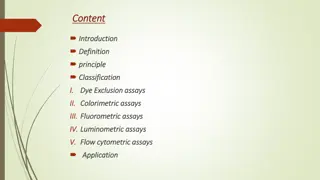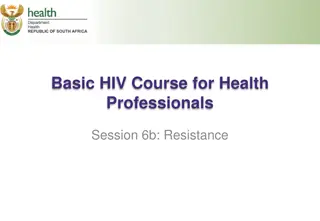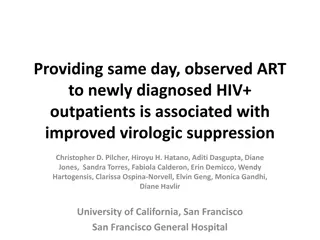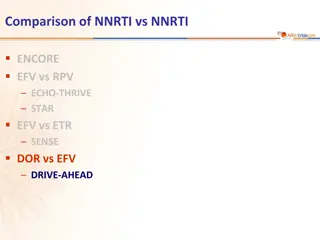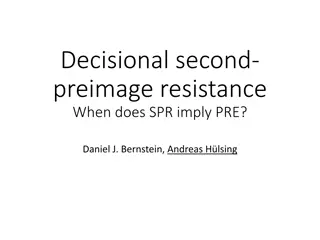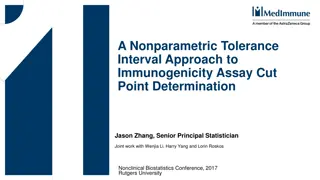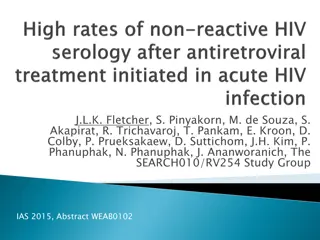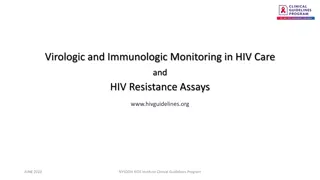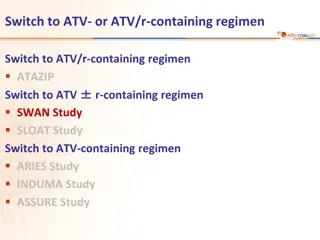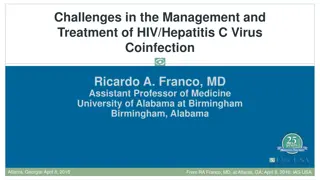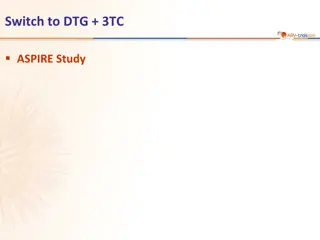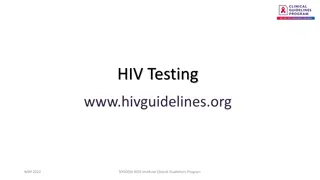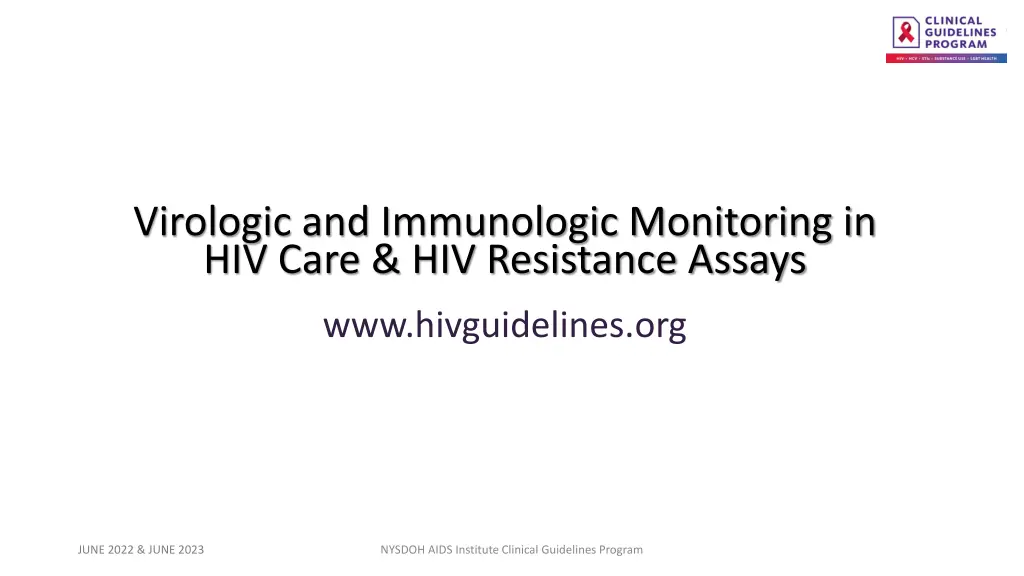
Virologic and Immunologic Monitoring in HIV Care Guidelines
Get insights on virologic and immunologic monitoring in HIV care, including recommendations for viral load and CD4 count testing intervals, addressing adherence barriers, and achieving optimal treatment outcomes with resistance assays.
Download Presentation

Please find below an Image/Link to download the presentation.
The content on the website is provided AS IS for your information and personal use only. It may not be sold, licensed, or shared on other websites without obtaining consent from the author. If you encounter any issues during the download, it is possible that the publisher has removed the file from their server.
You are allowed to download the files provided on this website for personal or commercial use, subject to the condition that they are used lawfully. All files are the property of their respective owners.
The content on the website is provided AS IS for your information and personal use only. It may not be sold, licensed, or shared on other websites without obtaining consent from the author.
E N D
Presentation Transcript
Virologic and Immunologic Monitoring in HIV Care & HIV Resistance Assays www.hivguidelines.org JUNE 2022 & JUNE 2023 NYSDOH AIDS Institute Clinical Guidelines Program
Purpose of This Guideline Purpose of This Guideline Virologic & Immunologic Monitoring Guide clinicians in the use of HIV viral load testing at appropriate times and intervals to assess initial and ongoing ART responses. Clarify the appropriate use of immunologic (CD4 count) monitoring in the care of patients with HIV. HIV Resistance Assays Assist clinicians in determining when to order HIV drug resistance testing Inform clinicians about the different types, benefits, and limitations of currently available resistance assays Assist clinicians in choosing resistance testing to improve treatment outcomes JUNE 2022 & JUNE 2023 NYSDOH AIDS Institute Clinical Guidelines Program www.hivguidelines.org
Recommendations: Viral Load & CD4 Count Recommendations: Viral Load & CD4 Count Monitoring Intervals Monitoring Intervals To assess a patient s response to ART and immunologic status and to identify when a change in ART regimen is needed, clinicians should perform plasma HIV-1 RNA level (viral load) and CD4 count testing as detailed in Recommended Viral Load and CD4 Count Monitoring in Nonpregnant Patients With HIV. (A1) Clinicians should address modifiable barriers to adherence and engagement in care to help ensure optimal virologic suppression. Modifiable barriers may include but are not limited to, substance use, mental illness, other chronic medical conditions, ART-associated adverse medication effects, unstable housing, or low health literacy. (A2) Quarterly CD4 count monitoring is no longer recommended for nonpregnant patients receiving ART who have consistently undetectable viral load levels and CD4 counts >200 cells/mm3. (A2) JUNE 2022 NYSDOH AIDS Institute Clinical Guidelines Program www.hivguidelines.org
Key Points: Viral Load Key Points: Viral Load Quarterly HIV RNA monitoring remains appropriate for patients with a recent history of nonadherence, mental health disorders, substance use, homelessness, poor social support system, or other major medical conditions. Semiannual monitoring may be appropriate for patients with persistently undetectable HIV RNA and none of the above characteristics. Achieving and maintaining an undetectable viral load is always the goal of ART. JUNE 2022 NYSDOH AIDS Institute Clinical Guidelines Program www.hivguidelines.org
Recommended Viral Load and CD4 Count Monitoring Recommended Viral Load and CD4 Count Monitoring in Nonpregnant Patients With HIV: Baseline in Nonpregnant Patients With HIV: Baseline Event HIV RNA Viral Load CD4 Count Comments If a patient is not taking ART, recommend initiation (A1) Monitor as below Entry into care Baseline viral load (A1) Baseline CD4 count (A1) JUNE 2022 NYSDOH AIDS Institute Clinical Guidelines Program www.hivguidelines.org
Recommended Viral Load and CD4 Count Monitoring Recommended Viral Load and CD4 Count Monitoring in Nonpregnant Patients With HIV: Patients Taking ART in Nonpregnant Patients With HIV: Patients Taking ART Event HIV RNA Viral Load CD4 Count Comments Within 4 weeks after ART start or change (A3) At least every 8 weeks until complete virologic suppression is documented (A3) 12 weeks after ART initiation Every 4 months until CD4 count >200 cells/mm3 is obtained on 2 measurements at least 4 months apart (A2), then monitor as below once virologic suppression is achieved Virologic failure occurs when a viral load <200 copies/mL is either not achieved or not maintained Virologic suppression is defined as a viral load <20 to <50 copies/mL obtained with a highly sensitive assay ART initiation or change to address virologic failure ART change for simplification or due to adverse effects Within 4 weeks after ART change, then as below (A3) Monitor as below for documented virologic suppression -- At least every 4 months (A3) May extend interval to 6 months in patients stable on ART with CD4 count >200 cells/mm3 and complete viral suppression for 1 year (B2) At least every 6 months if CD4 count is 350 cells/mm3 (B2) Optional if CD4 count is >350 cells/mm3 (B2) Documented viral suppression -- JUNE 2022 NYSDOH AIDS Institute Clinical Guidelines Program www.hivguidelines.org
Recommended Viral Load and CD4 Count Monitoring Recommended Viral Load and CD4 Count Monitoring in Nonpregnant Patients With HIV: Patients Taking ART, in Nonpregnant Patients With HIV: Patients Taking ART, continued continued Event HIV RNA Viral Load CD4 Count Comments Assess for adherence and drug-drug interactions (A3) Obtain resistance testing (A1) New HIV RNA 500 copies/mL after previous viral suppression Repeat viral load test 2 weeks after first result (A2) Obtain CD4 count if previous result is >6 months old (B3) Assess for adherence and drug-drug interactions (A3) If repeat viral load is detectable, consider resistance testing (B3) Patients with low-level viremia 200 copies/mL over a period of 12 months without demonstrated failure may continue routine testing intervals of at least every 4 months New HIV RNA level over the limit of detection of sensitive assays, 20 to 50 copies/mL, but <500 copies/mL after previous viral suppression Repeat viral load test within 4 weeks to differentiate low- level transient viremia ( blip ) from virologic failure (A2) If repeat viral load is detectable, obtain CD4 count if previous result is >6 months old (B3) JUNE 2022 NYSDOH AIDS Institute Clinical Guidelines Program www.hivguidelines.org
Recommended Viral Load and CD4 Count Monitoring in Recommended Viral Load and CD4 Count Monitoring in Nonpregnant Patients With HIV: Patients Not Taking ART Nonpregnant Patients With HIV: Patients Not Taking ART Event HIV RNA Viral Load CD4 Count Comments CD4 count 500 cells/mm3 (A2) At least every 4 months At least every 4 months At every visit, recommend ART initiation CD4 count >500 cells/mm3 (A2) At least every 6 months At least every 6 months At every visit, recommend ART initiation JUNE 2022 NYSDOH AIDS Institute Clinical Guidelines Program www.hivguidelines.org
Interpretation of Viral Load Interpretation of Viral Load JUNE 2022 NYSDOH AIDS Institute Clinical Guidelines Program www.hivguidelines.org
FDA FDA- -Approved Quantitative HIV Approved Quantitative HIV- -1 RNA Assays for Viral Load Monitoring for Viral Load Monitoring 1 RNA Assays Test Name Method Lower and Upper LOQ 40 copies/mL 10,000,000 copies/mL 20 copies/mL 10,000,000 copies/mL 20 copies/mL 10,000,000 copies/mL 34 copies/mL 10,000,000 copies/mL Abbott RealTime HIV-1 (Abbott Laboratories) Real-time PCR Cobas AmpliPrep/Cobas TaqMan HIV-1 Test, version 2.0 (Roche Diagnostics) Real-time PCR Cobas HIV-1 quantitative NAT for use on Cobas 6800/8800 systems (Roche Diagnostics) Real-time PCR Cobas TaqMan HIV-1 Test, v2.0 for use with the high pure system (Roche Diagnostics) Real-time PCR JUNE 2022 NYSDOH AIDS Institute Clinical Guidelines Program www.hivguidelines.org
Recommendations: Determining HIV Drug Recommendations: Determining HIV Drug Resistance Resistance Clinicians should consult with an expert HIV care provider to interpret the results of resistance assays because such results can be complex. (A3) Clinicians should perform genotypic resistance testing that includes the protease (A2), reverse transcriptase (A2), and integrase genes (B2) at baseline. For a patient experiencing treatment failure or incomplete viral suppression while taking oral ART, the clinician should perform resistance testing while the patient is still on therapy but no later than 4 weeks after stopping ART, to minimize the rapid return of wild-type virus when the selective pressure from ART is removed. (A2) For patients receiving CAB/RPV LA, the clinician should obtain resistance testing while the patient is still on or as soon as possible after they have discontinued effective ART, although the time limit for obtaining useful resistance information after discontinuation of CAB/RPV LA is unknown. (A3) Clinicians should perform coreceptor tropism testing before initiating a CCR5 antagonist. (A1) For patients whose treatment with a fusion inhibitor has failed, the clinician should test for fusion inhibitor resistance as a supplement to other genotypic resistance testing. (A2) JUNE 2023 NYSDOH AIDS Institute Clinical Guidelines Program www.hivguidelines.org
Key Point: Determining HIV Drug Resistance Key Point: Determining HIV Drug Resistance Resistance testing is recommended when incompletely suppressive ART is interrupted. Because of the rapid return of wild-type virus without selective pressure from ART, testing is preferred before treatment is stopped. If the patient has already stopped ART, testing should be performed as soon as is practical and, if possible, no more than 4 weeks after cessation, before the return of wild-type virus. If resistance testing is performed more than 4 weeks after ART cessation, some mutations may no longer be detected by the assay and clinically relevant mutations may not be recognized. For patients who were receiving CAB/RPV LA, resistance testing should be done as soon as possible but may be useful any time after cessation of ART. JUNE 2023 NYSDOH AIDS Institute Clinical Guidelines Program www.hivguidelines.org
Need Help? Need Help? NYSDOH AIDS Institute Clinical Guidelines Program www.hivguidelines.org
Access the Guidelines Access the Guidelines www.hivguidelines.org > Virologic and Immunologic Monitoring in HIV Care & HIV Resistance Assays Also available: Printable pocket guide and PDFs Virologic and Immunologic Monitoring in HIV Care HIV Resistance Assays NYSDOH AIDS Institute Clinical Guidelines Program www.hivguidelines.org



